英国服饰文化英文版
- 格式:ppt
- 大小:2.56 MB
- 文档页数:26
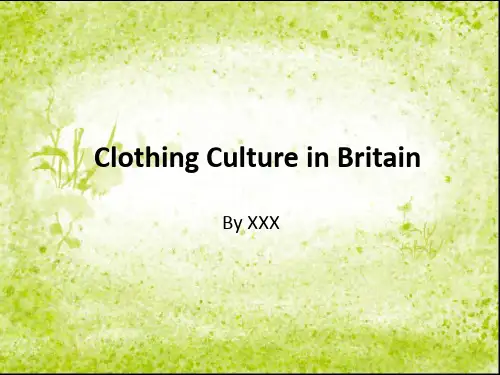

各个国家服饰文化英语作文Title: The Cultural Tapestry of National DressThe world is a vast canvas, each thread in its weave representing a unique culture, and among the most vivid threads are those that depict national dress. The attire of a nation serves not only as a marker of identity but also as an emblem of its history, values, and societal norms. In this essay, we will explore the rich tapestry of national dress across different countries, revealing the stories and significance woven into every garment.In Japan, the kimono is a graceful and elegant reminder of the country’s reverence for tradition. This formal garment, characterized by its straight lines and wide sleeves, often features intricate patterns that narrate tales of seasonal change, flora, and fauna. The act of wearing a kimono encapsulates the Japanese philosophy of harmony, simplicity, and a deep connection to nature.Traversing the globe to Africa, the diversity of traditional clothing mirrors the continent's vast cultural mosaic. In West Africa, the vibrant and colorful garments such as the Dashikifrom Nigeria or the Grand Boubou from Senegal and Mali, tell stories of craftsmanship passed down through generations. These attires, often adorned with elaborate embroidery and symbolic patterns, reflect the social status and ethnic identity of the wearer.Moving to the opposite side of the spectrum, we find the crisply tailored suits and conservative dresses of Britain. The United Kingdom’s national dress reflects the country’s history of propriety, class structure, and an understated sense of elegance. Tweeds and woolens, particularly in earthy tones, showcase the cool and sometimes damp climate of the region while maintaining a steadfast commitment to tradition and a quietly authoritative presence on the global stage.In India, where festivals paint the calendar with vibrant hues, the national dress known as the sari epitomizes both elegance and practicality. This unstitched piece of cloth, draped in various styles across regions, comes alive with extravagant colors and patterns. It is not merely a garment but a cultural icon signifying femininity, grace, and resilience.Australian aboriginal art finds expression on modern attire, blending the ancient with the contemporary. Traditional cloaks,adorned with dreamtime stories through intricate dot paintings, connect the past to the present, while also serving as a political statement about sovereignty and cultural survival.In Scandinavian countries like Sweden, simplicity and functionality reign supreme. Garments are designed to endure the harsh winters, with thick fabrics and thoughtful constructions that ensure warmth without sacrificing style. Clothes often come in neutral tones, reflecting the minimalist aesthetic that is harmoniously attuned to the long dark nights and white landscapes of the north.As we journey through these diverse expressions of national dress, it becomes evident that clothes are more than mere fabric; they are the skin we wear to communicate who we are to the world. They speak of our ancestors' wisdom, our community's values, and our personal identity. Each garment, like a word on a page, contributes to the story of our human tapestry – a tale of diversity, resilience, and beauty.In conclusion, national dress is a testament to the intricate interweaving of culture, history, and identity within the fabric of global society. As keepers of our heritage and creators of our future, it is our role to appreciate and preserve these distinctiveexpressions, allowing the narrative of national dress to continue unfolding, one thread at a time.。
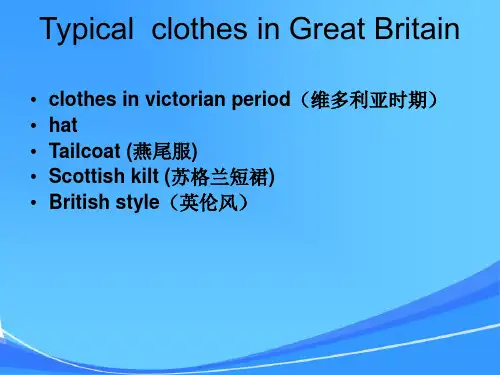

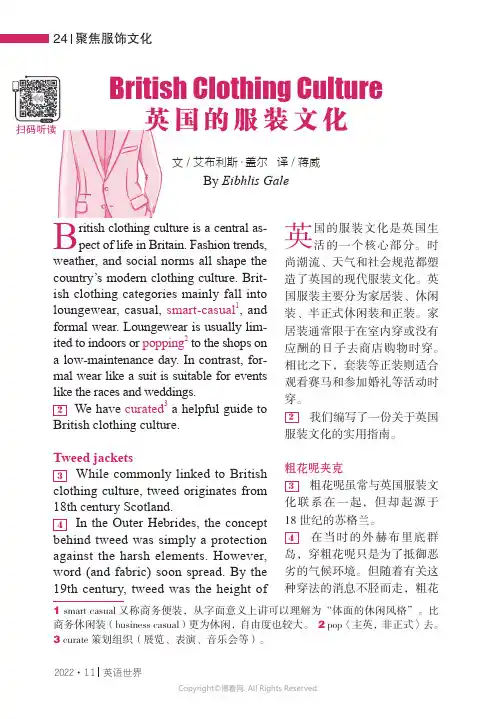
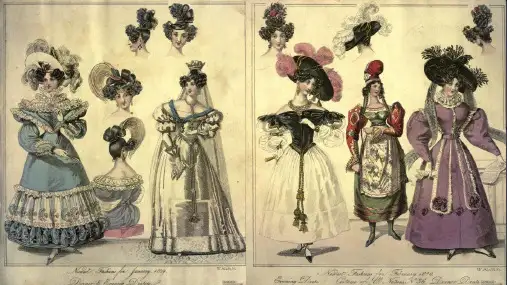
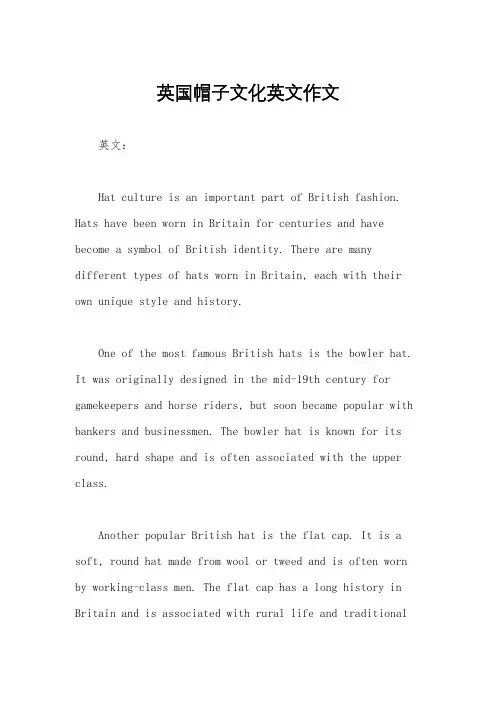
英国帽子文化英文作文英文:Hat culture is an important part of British fashion. Hats have been worn in Britain for centuries and have become a symbol of British identity. There are many different types of hats worn in Britain, each with their own unique style and history.One of the most famous British hats is the bowler hat. It was originally designed in the mid-19th century for gamekeepers and horse riders, but soon became popular with bankers and businessmen. The bowler hat is known for its round, hard shape and is often associated with the upper class.Another popular British hat is the flat cap. It is a soft, round hat made from wool or tweed and is often worn by working-class men. The flat cap has a long history in Britain and is associated with rural life and traditionalvalues.In addition to these hats, there are many other styles worn in Britain, such as the top hat, the fedora, and the beanie. Each style has its own unique history and cultural significance.Hat culture is not just limited to fashion, it also plays a role in British social etiquette. For example, it is considered rude to wear a hat indoors, especially in formal settings. Hats are also often worn at weddings and other special occasions.Overall, hats are an important part of British culture and fashion. They have a rich history and continue to be worn today as a symbol of British identity and style.中文:帽子文化是英国时尚的重要组成部分。
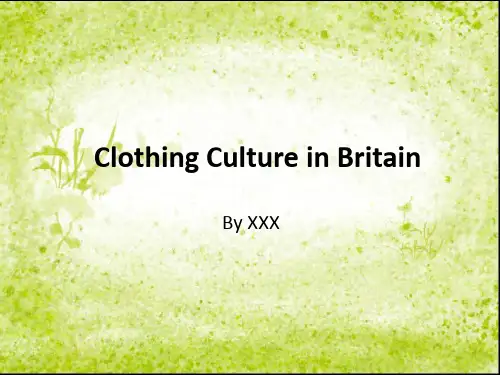
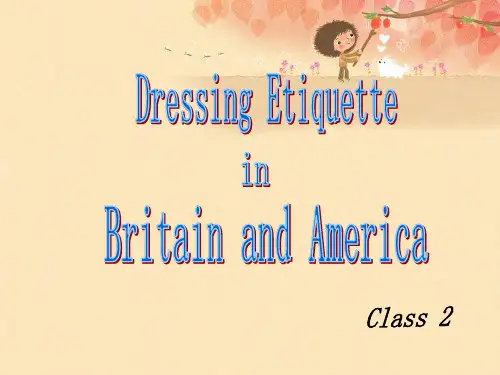
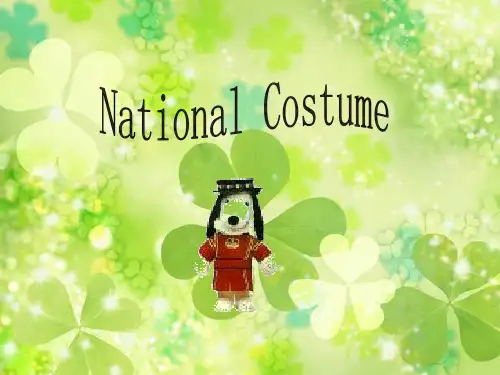
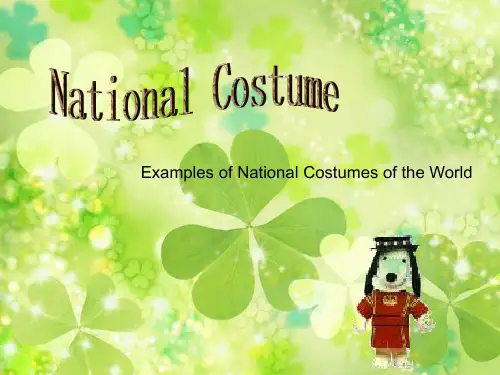
英国文化系列之英国传统服饰的演变与特色Evolution and Characteristics of Traditional Clothing inBritish CultureIn the tapestry of global cultures, the threads of British traditional clothing stand out with their rich history and unique charm. Tracing its genesis back to ancient times, this apparel has evolved over centuries, reflecting various epochs, social norms, and aesthetic preferences. This essay delves into the fascinating journey of British traditional clothing, highlighting its significant shifts and enduring characteristics.The earliest forms of British attire were heavily influenced by Celtic and Nordic traditions. These garments often featured intricate patterns, bold colors, and functional designs that suited the nomadic lifestyle of early settlers. Over time, as Roman and Norman conquerors arrived on these shores, new styles and fabrics were introduced, adding more diversity to the existing wardrobe.During the Tudor era, English fashion underwent a remarkable transformation. The introduction of sumptuary laws aimed at regulating class-based dress codes gave rise to distinctively English silhouettes. Men's attire emphasized doublets and hose, while women wore gowns adorned with lavish embroidery and pearls. The period also saw the emergence of nationalistic symbols like the Tudor rose, which became a prominent motif in clothing design.As the Industrial Revolution dawned, Britain experienced unprecedented economic growth and technological advancements. This shift had profound implications for clothing production and consumption. Mass production techniques led to cheaper fabrics and faster turnaround times, making fashionable clothes accessible to wider segments of society. Victorian era fashion, characterized by bustles, crinolines, and elaborate lace work, reflects this era's obsession with excess and ornamentation. Post-Victorian times witnessed yet another revolution in fashion, driven by changing societal attitudes towards gender roles and personal expression. Women's suffrage movements coincided with the popularization of practical and comfortable dresses like the Edwardian suit or the flapper dress, both embodying female empowerment and independence. Men's attire also loosened up, shifting away from stiff formalwear towards more casual and relaxed fits.Modern British fashion continues to draw inspiration from its rich heritage while embracing contemporary trends. Classic elements such as tweeds, checks, and tartan patterns remain popular choices amongst designers and consumers alike. At the same time, there is an increasing emphasis on sustainability and ethical production methods, reflecting a growing awareness about environmental issues and consumer responsibilities.British traditional clothing is not just about aesthetics; it is a window into the country's past, present, and future. Ittells stories of royal pomp, industrial triumphs, feminist rebellions, and cultural exchanges across borders. As we look ahead, it seems likely that this vibrant tapestry will continue to evolve, blending old world charm with modern sensibilities to create truly timeless pieces of artistry and craftsmanship.。
小学英语人教PEP新版三年级上册英国的着装文化在英国,民族服饰很有特点。
首先是帽子,其中最突出的就是英国绅士的圆顶硬礼帽——“波乐帽”(bowler hat),它是一种硬胎圆顶呢帽,通常是黑色。
传统上英国要人、名流显贵都要戴上这种礼帽,文艺作品中一提到B.H,读者可以立即联想到一位英国绅士。
现在在各大城市的大街上,这种波乐帽已不多见,但并未消失。
其次是英国人的各种传统的工作服装和服饰,包括:法院开庭时法官穿的黑袍、戴的假发,教堂礼拜时牧师所披的长袍,历届国会开会时女王所穿的白色长裙礼服、戴的王冠(其间坐在前排的“司法贵族”穿戴黑袍假发,“宗教贵族”着翻领红袍),还有王宫卫士所穿的鲜艳的短外衣、黄束腰、高筒黑皮帽,伦敦塔楼卫士的黑帽、黑衣,近卫骑士的黑衣、白马裤、黑长靴等等。
再次苏格兰人视苏格兰短裙为“正装”,在婚礼或者其他较为正式的场合才穿。
直到现在,苏格兰的军队还把苏格兰短裙当成制服。
黑色的呢子上装,白色的衬衫,花格呢裙,羊毛袜,再配上同样花型的格呢披肩和有兽皮装饰的系于腰间的酒壶,一个标准的苏格兰男子的形象就跃然眼前。
在英语中,苏格兰短裙被称为“kilt”,这是地道的苏格兰语。
关于此短裙的起源,英格兰人和苏格兰人一直有争论。
有一种说法是:一个名叫汤姆·罗琳逊的英格兰人最早倡导穿苏格兰短裙。
据记载,1715年,英国政府采取开放政策,允许英格兰、苏格兰两地的人们互通贸易,汤姆·罗琳逊便是从中受益、北上淘金的商人之一。
他在苏格兰北部开了家木炭画加工厂,苏格兰短裙就是他在工人中推广的工作服。
传统的苏格兰服饰“kilt”,原本包括宽大的披肩,披肩和短裙连成一体,在砍树时很不方便,汤姆·罗琳逊便向裁缝提出,将“kilt”一剪为二,苏格兰短裙由此诞生。
但是,也有记载表明,早在1624年,苏格兰军队就将苏格兰短裙作为军队的制服了。
“穿苏格兰短裙不穿内裤”的说法也一直在流传。
一种解释是:只有在跳舞的时候才需要穿内裤;如果穿有衬里的苏格兰裙,内裤似乎就成了累赘;穿没有衬里的毛料苏格兰裙,内裤就不可缺少;是否需要穿内裤取决于天气、个人习惯以及要出席的场合等。